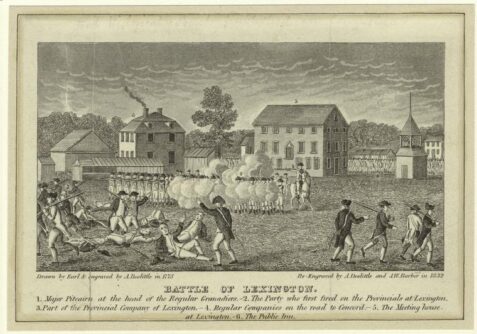Obsession with numbers and metrics does the philanthropist—and his grantee—no favors.
What motivates the do-gooder to do good, especially when done through a considered, structured, and government-sanctioned means?
A related, two-part question: Is the objective of an American philanthropy to do good; to do right by and for the neighbor in need? Or, does the philanthropy or foundation exist—in practice—for the unspoken purpose of efficiency, accomplished by creating and emphasizing a market-analytical, professionally credentialed, numbers-crunching mechanism that aspires, either secretly or unabashedly, to reshape the concept of charity into an approximation of a venture-capital operation? A thing snug and at home in the function fields and gridwork of determinative spreadsheets, with the tabulating numbers mandating what such numbers are supposed to mandate (as preached by America’s managerial gurus): evidence, proof, and a return on investment?
Or: Is philanthropy something that’s somewhere in between the poles of basic charity and exalted efficiency?
Another or: Is this any of our business? After all, the largesse to be shared, spread, spent, and showered is that of the grantor, of the benefactor, not—until given, until received—that of the grantee or the beneficiary. The source of bounty—the individual philanthropist or the foundation trustees empowered to allocate, to declare terms, to demand oversight—is free to dictate whatever criteria desired to assess the worthiness of nonprofits, including attaching strings (if not ropes) to dollars given, in the name of supporting the donors’ charitable and strategic mission.
Even in such cases where the giving guidelines and procedures can be judged—whether by the aspiring beneficiary or the informed observer—as prescribing an excruciating grant-application process, layered over with an ensuing course of metrics-driven assessment that is overseen by a team of bona fide, college-certified charity professionals, that fundamental fact—My Money, My Say-So—governs.
You don’t like the ground rules? You brisk at the exacting standards, the strict adherence to the tangible, the bias for new projects, the demand for updates and numbers and reports which provide evidence that the philanthropist’s money was spent efficiently, wisely, and with calculable effect? You have something against “maximizing impact,” against “effective philanthropy,” against “impact investing”?
Then don’t apply.
A bit harsh, this characterization? Maybe. Like most things in life, truth lies in the middle, alongside the devil in the details. Still, it is foolhardy to deny that there is an ascending and existential pressure for metrics and measurements – determinative and domineering and waxing, while the role of judgment wanes—in philanthropy, as if it were just another field or occupation category, as if charity were to be treated no differently from the making of widgets.
As if the cardinal virtues were subservient to cardinal numbers.
Catholic University historian Jerry Muller addresses this reality in the title of his book, The Tyranny of Metrics, contending that the practice has infiltrated and influenced all society, sometimes with harmful effect. Engagement in corporal works of mercy is no exception. The managerial mavens have ruled: Charity is something best left in the hands of—you guessed it: professionals.
THE PROFESSIONAL IMPULSE
How did it come to this, this evolution from the benevolent Samaritan to the charity run by bureaucracies of the credentialed?
Time out for an anecdote: Some years back, a friend of my then-high-school daughter, hanging out at our home, talked of future plans, certain but nebulous, too. First, she would attend a prestigious college. Next, she’d get a graduate degree in some unspecified field. And then would come a career commencing with a job in a nonprofit.
Asked, “What nonprofit?” the shoulders shrugged.
A brief inquiry from a friend’s father, it proved a personal eureka moment, a dawning of the fact—and it is a fact—that this goal of being a nonprofit professional, for its own sake, absent of specificity of cause or mission or institution, was a new reality, a new mindset, and indeed a career path for the then-emerging generation.
At some point, maybe when America was distracted by making profits to endow and fund nonprofits, while socialism claptrap was infiltrating secondary-school classrooms, the idea of a nonprofit as both an employment objective—as a moral, legitimate, even preferable alternative to working for a business or an agent of capitalism—and as a career had gained a hold in minds of looming social-justice warriors.
Some parents, not aloof, practical and prudent, ever on the lookout for advantages for their darlings, saw something too in this nonprofit stuff. It could be a tool for advancing and assuring their college-bound declared-exemptions a place in more elite institutions.
Scheming commenced. It was embraced with gusto. And herewith another anecdote: A year or so following the illuminating conversation with my daughter's pal (who indeed became a proud "nonprofit professional”), attending a function at an Ivy League institution, seated at a table with undergraduates, the conversation turned to their teen-aged contrivances of nonprofits. Each student’s accounting described some on-steroids high-school project, cast by mom and dad and the family lawyer on federal forms as a deserving charity, and the granting of formal 501c3 status by the Internal Revenue Service, which now seems to spend much bureaucratic time approving potent enhancements to college applications.
And so nonprofits—important but once-rare things, surely off the beaten career path, considered the purview of the rich benefactor or the Dorothy Day or the cure-seeking scientist, had become culturally mainstream, upper-crust utilitarian, and indeed, a profession.
TO WHAT DEGREE?
The Scarecrow wanted a brain, but the Wizard of Oz derided the request, granting him instead a diploma, with the honorary “PhT” degree – a Doctor of Thinkology, which once bestowed led to straw man’s spouting of a bastardized Pythagorean Theorem.
And so it has gone and continues to go in America: That parchment boasting letters like “B.A.” and “B.S.” and “M.S.” and a host of other acronyms is a necessity, or at least a means of enhancement. It implies capabilities—or at least the impressive impressions of talent, knowledge, and ability—unavailable to the non-diploma’d. Even when—maybe even especially when—it comes to distributing charitable dollars.
Satisfied with a mere “Certificate in Philanthropy?” To pick one of many, Notre Dame of Maryland University’s program (providing “the training necessary to lead institutions and organizations into an ever-changing future”) will grant such, thereby smoothing your career path towards managing fundraising and grant-writing, or directing “major” and “corporate” giving duties, and even empowering certificatees to all-out run foundations.
The School of Professional Studies at Northwestern University, in Chicago, has a range of similar programs which may earn you a “Philanthropy and Nonprofit Organizations” certificate, with upgrades for those seeking to run down "Fundraising Professional" and "Nonprofit Professional" certificate tracks.
Opportunities for full-bodied academic degrees abound. At Northeastern University in Boston, the College of Social Sciences and Humanities offers a graduate degree in “Nonprofit Sector, Philanthropy, and Social Change” (alas, no “and Charity”).
As we move west, the University of Denver offers a Masters in “Philanthropy and Resource Development,” describing it thus:
Changes in philanthropy, resource development, and fundraising are shaping the giving environment that influences how nonprofit and/or nongovernmental organizations plan their funding strategies. From crowdsourcing campaigns to capital fundraising and legacy giving, nonprofits must cultivate and retain donors from diverse contexts, devise new fundraising strategies, and demonstrate impact. Learn to navigate these changing trends through the master's degree concentration in Philanthropy and Resource Development. You’ll increase impact and your nonprofit’s mission through diverse fundraising approaches.
And of course, the most-determined academic embrace of philanthropy may be found at Indiana University, home of the endowed Lilly Family School of Philanthropy. Operating since 2012 and calling itself the “world’s first school dedicated solely to the study and teaching of philanthropy,” it is the evolution of IU’s Center on Philanthropy, which was founded a quarter century earlier.
There’s also much offered at the full-blown and global CFRE International: a broad array of training and exams may conclude with the status achievement of “Certified Fund Raising Executive,” (entitling one to frameable certificates and, à la Good Housekeeping and UL symbolizing, permission to place official badges on business cards).
AND WHY NOT PROFESSIONALIZE?
While philosophy majors may have huge challenges finding careers in philosophy, colleges and universities long ago figured out that scholarship and coursework in philanthropy tapped into a burgeoning slice of the American work force. There is money to be made in an exciting career in fundraising, and Uncle Sam has the evidence. It’s copious.
The U.S. Bureau of Labor Statistics’ Occupational Outlook report from 2020 for fundraisers (average annual pay: $59,610) predicts “Employment of fundraisers is projected to grow 14 percent from 2019 to 2029, much faster than the average for all occupations. Employment growth is expected to be driven by the continued need of various types of organizations to raise money.”
And then there is the step-above employment slice the Bureau designates Fundraising Managers (which it lumps together with Public Relations Managers). The pay potential there is double that of the mere fundraiser: $118,430. But it comes at a price: “Some employers prefer to hire candidates who have a master’s degree, particularly in public relations, journalism, fundraising, or nonprofit management.”
TYRANNY OF THE GURUS
Not bad in itself, the ardent professionalizing of philanthropy comes at a time when entire fields of American life—from business to policy to education—has come under the sway of what the great James Burnham described as the “managerial revolution,” a concept repackaged and vigorously taught over the decades by American MBA schools and cocky guru authors of a book tsunami—boldly preaching “highly effective” this, “outliers” that—in various presumptive ways claiming that just about everything—from life insurance to life coaching—can be . . . managed. And that all organizations—the widget consortium, and the food bank—are essentially the same thing, and therefore can be addressed and administered by standard practices, by one-size-fits-all decision-making that is dependent on measurements, which have rendered quaint and useless judgment, now orphaned in the boardroom and the operations manual.
It is a world in which no one cares what your “gut” tells you.
IT’S MULLER TIME
Well, not no one. This dictating of processes and calculating and sameness-applied, this obsession with quantifying human performance, are what the aforementioned Professor Muller, student of the practices and effects of the reigning managerial monopoly, has analyzed and called out in his powerful 2018 book, The Tyranny of Metrics. In its Introduction, Muller decries the pervasiveness and overreliance of decision-making that is based exclusively on quantifying. There is a consequence: “gaming the metrics.” Muller holds that it
occurs in every realm: in policing; in primary, secondary, and higher education; in medicine; in nonprofit organizations; and, of course, in business. And gaming is only one class of problems that inevitably arise when using performance metrics as the basis of reward or sanction. There are things that can be measured. There are things that are worth measuring. But what can be measured is not always what is worth measuring; what gets measured may have no relationship to what we really want to know. The costs of measuring may be greater than the benefits. The things that get measured may draw effort away from the things we really care about. And measurement may provide us with distorted knowledge—knowledge that seems solid but is actually deceptive.
We live in the age of measured accountability, of reward for measured performance, and belief in the virtues of publicizing those metrics through “transparency.” But the identification introduction of accountability with metrics and with transparency is deceptive. Accountability ought to mean being held responsible for one’s actions. But by a sort of linguistic sleight of hand, accountability has come to mean demonstrating success through standardized measurement, as if only that which can be counted really counts. Another assumption that is often taken for granted is that “accountability” demands that measurement of performance be made public, that is, “transparent.”
The metric fixation is the seemingly irresistible pressure to measure performance, to publicize it, and to reward it, often in the face of evidence that this just doesn’t work very well.
Used properly, measurement, as we’ll see, can be a good thing. So can transparency. But they can also distort, divert, displace, distract, and discourage. While we are bound to live in an age of measurement, we live in an age of mismeasurement, over-measurement, misleading measurement, and counter-productive measurement.
In a public forum discussing the book’s themes and conclusions, Muller connected the dots: The fixation with “measured performance outcomes,” the concoction of business-school leaders, holds that all entities and organizations, including philanthropies, “are fundamentally the same. And so they can all be managed by the same tools. You don’t need experience. You don’t need judgment. It’s all a matter of technique.”
Muller’s is not a diatribe against metrics per se, but its tyranny. To him, and one hopes to all, it is obvious that “measurement is often useful when combined with judgment, based on experience.”
But the doctrine of the numbers’ fetishist—“what gets measured gets done”—is simply not true, says Muller. Nor is the attending MBA-taught principle that people necessarily respond to incentives (“to reward them if standardized measures are high, or penalize them if they fail to reach the measured targets”), particularly those made public via all-the-world-to-see scorecards and rankings, generating increasing shame for those entities falling further down the lists.
How has this, the ruler and yardstick, affected the world of charity? In general, says Muller,
there is an overvaluation of the metrics and there is an undervaluation of all the energy and time that gets diverted into the process of measurement. And this is particularly growing. People in philanthropies tell me it is terrible there. All the donors want you to measure everything, and a lot of the most important things the philanthropies don't want to give you additional money to do the measuring
The “diversion of attention” that results from the metrics tyrannizing means that in-need grant applicants often must shift requests for support to those matters which can be measured—things not necessarily at the core of a nonprofit’s mission, or what truly can make a claim for legitimate, charitable support.
“Ultimately,” he contends, “the issue is not one of metrics versus judgment, but metrics as informing judgments, which includes knowing how much weight to give to metrics, recognizing their characteristic distortions, and appreciating what can’t be measured.”
MEASURING UP DOESN’T MEASURE UP
Who (gulp!) wants to lecture the philanthropist or the donor with a metrics affinity—or the foundation agent who has written a thesis on the virtues of charitable ROI or the requirement to quantify outcomes—what road good intentions may be paving?
Some people have found the nerve and publicly stepped up to make the case for backing away from numbers, to explain the onus that metrics-obsession can place on charitable entities, especially those of limited manpower and limitless dilemma.
An example: Writing for the Chronicle of Philanthropy in 2016, the Aspen Institute’s Maureen Conway provides a telling case study in how numbers worship is, to many, a panacea—one that has the likelihood of missing critical points and realities. Why? It should be obvious: Not everything that is vital can be measured and tabulated. Regardless, the obsessed obsess, no matter the harm such might cause in the precincts of charitable giving. “Big data,” Conway says, “has stolen the hearts of many industries, and philanthropy is no exception.”
Her pitch may not be against metrics, but against the infatuation with them, and the need to consider charitable giving that is not exclusively genuflecting before data:
Individual outcomes are important. At the end of the day, we want to help individuals. But doing so on a large scale will take more than just adding up individual outcomes—it will require looking at the larger picture and building strategies to address it.
Philanthropy needs to get comfortable with ambiguity in measurement, or else it will miss critical opportunities to make lasting change.
This is one woman’s opinion. But is that all it is—an observation of one soul, maybe even an iconoclast, whose analysis might be framed by unusual anecdotes, experiences, or prejudices?
Maybe. But, unlikely.
Another piece in the Chronicle, this by Joan Garry, considered the particular struggles handicapping on-a-shoestring, community nonprofits, discussing with leaders of institutions at the front lines of civil society—the very ones (tiny-staffed!) which deal with hard local problems. On the wish list is not a call for more metrics and analysis, but a . . . charitable . . . consideration from donors of the realities many organizations face. From one leader came this request:
Please stop treating us as if we have lots of paid staff. We do meaningful work, and we are proud of it, but we only have 1.25 staff members and a posse of volunteers. I write the grant proposals and pay the bills. I would love to have the resources to build a strategy and a vision to meet each foundation’s requests, but I just can’t dedicate the time needed to adhere to lengthy proposal requirements.
WHAT PAVES THE ROAD TO JERICHO?
It might be worth recalling just what this concept and practice, this motivation and for many, a means of spiritual salvation – charity – is; at least as it is articulated by our federal statutes applicable to taxation. Why paraphrase when the Internal Revenue Service itself states,
The exempt purposes set forth in section 501(c)(3) are charitable, religious, educational, scientific, literary, testing for public safety, fostering national or international amateur sports competition, and preventing cruelty to children or animals. The term charitable is used in its generally accepted legal sense and includes relief of the poor, the distressed, or the underprivileged; advancement of religion; advancement of education or science; erecting or maintaining public buildings, monuments, or works; lessening the burdens of government; lessening neighborhood tensions; eliminating prejudice and discrimination; defending human and civil rights secured by law; and combating community deterioration and juvenile delinquency.
The objective of charity is not wealth, not fame (well, maybe for some), but itself: charity. It is a practice and a habit; indeed, a formal virtue for many a worshiper. To engage in charity often means being informed by numbers. By metrics. By observation and analysis, scientific method, and, if it might matter, by even slide rules and pressure gauges. And yes, by reports—this is how your generosity was spent.
But all this must be tempered by reality. And here is a massive reality: In our Judeo-Christian tradition, a principal wellspring of the Western concept of charity is the New Testament story of the robbed and beaten man, helped by the Samaritan passing by the way. To the worshiper, this tale unlocks the code to salvation. It recounts the same lessons as do countless other tales, as do the very realities faced daily: Sometimes, much of the time, a confronting need or inconvenient situation is completely unmeasurable, which does not abrogate the moral requirement for a material response or remedy.
This unanticipated, unasked, often unpleasant confronting may also, strangely, be an opportunity. To do good. Its response may require judgment, faith, wisdom and, if need be, swift action—unabetted by abacus or calculator or measuring stick.
Had the Biblical traveler, with the best of intentions for the bleeding man at his feet, engaged his quill with the papyrus spreadsheet, figuring a cost-benefit analysis, calculating what if any return there might be on his two-denarii investment (is Column B where one places the value of outlayed wine, oil, and bandages, plus travel time and donkey wear-and-tear?), it would likely have meant the half-dead victim lying before him would have promptly acquired the missing half of his demise.
Time—and the lack of its luxury, the pressure of the pending dilemma, and its demand for attention and immediacy—may be the central matter in this parable.
And most parables for that matter. Time is the thing, as goes the saying, that waits for no man. It also need not wait for metrics.
Everything in proportion, in balance, responding to present reality – this is justice, per the ancient Greeks. And why not per us moderns too? Proportion matters, and being open to the situational inapplicability of the dominant business-school doctrine – Professor Muller’s “tyranny of metrics” – is a prudent operating procedure for the philanthropist and the agent of generosity. Even for those with certificates and degrees.
For a field, a way of living, a way of engaging with and underwriting and protecting civil society, philanthropy—and the considered outlook of philanthropists, doers and givers, and the program officers who oversee missions—need to accommodate the principle that judgment is central to the doing of good. It must be on call for all matters requiring a charitable decision.
If the decision can be informed by metrics, professional analyses, ROI calculations, and the like, all the better. But often, these tactics and regimens may be neither available, nor applicable.
Philanthropists need to review their strategies to determine if their means of kindness have an overreliance on the metric, and have unduly diminished the role of prudence.
Numbers-fascination is a poor substitute for the most preeminent of the virtues.
Dilemmas and opportunities that require attention, generosity, and charity—those which do not neatly lend themselves to the calculable and bottom lines, those which can happen on the storied road from Jerusalem to Jericho—still demand responses of kindness, benevolence, and compassion.
It may be anathema to some, but at the crunch time, the one thing that just may not be available to be crunched are . . . numbers.
Jack Fowler serves as director of The Center for Civil Society, which provides research, trainings, and other resources that offer practical advice, ideas, and tools to help civil society leaders achieve their missions. The Center will host its first in-person conference for donors in Scottsdale, Arizona on Wednesday, November 17, 2021. Sign up to receive updates from Jack and to learn more about the Center's work promoting charity and civil society.







And all this leaves aside another equally undiscussed toxic issue: the prevalence of both donors and charities to pre-emptively believe that ethnicity of actor has some inherent, mystical relevance on the effectiveness of charity in terms of stewardship, issue, mission and audience. Just as dollars are fungible, so too are human behaviors. There should be no confusion. Charity is charity, not to be defined nor delivered nor measured by any other metric. To do otherwise is akin to worshipping a false God.